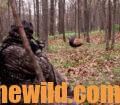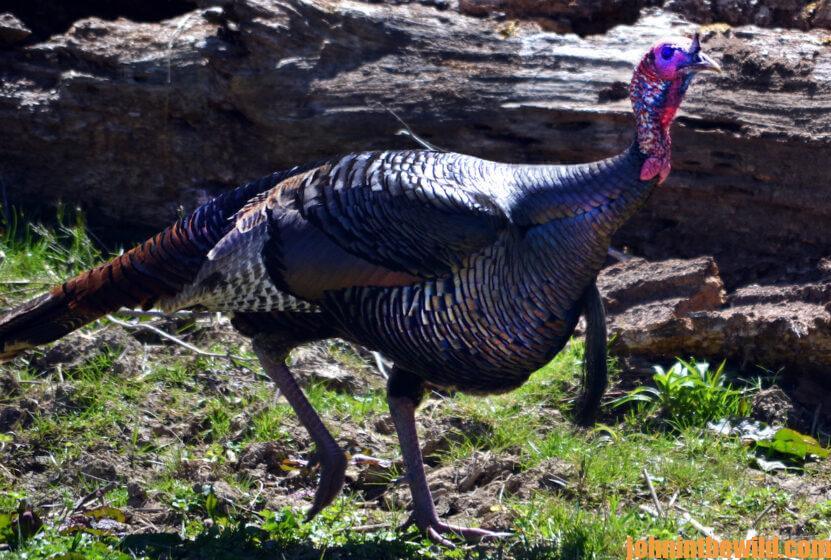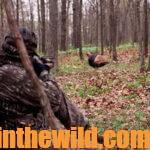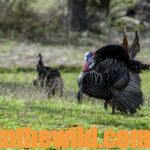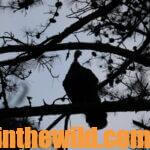Editor’s Note: Fred Darty, today of Tuscaloosa, Alabama, specialized in hunting canny old gobblers – birds that eluded other hunters many times. He learned in his years of hunting turkeys that no one else could take that, “A trophy turkey must be at least 5-years old and must have encountered many hunters. All but a handful of men have given up hunting him. He rarely will come to a hen or a caller. Caution has superseded his sex drive, and he’s probably the wisest creature in the woods.” Darty was like an Olympic athlete. He studied, he trained, and he polished his skills as he competed against the very-best adversaries he could find. He didn’t always win, but that’s what made his hunting turkeys worthwhile.
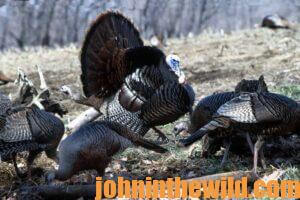 Most hunters believe their hunt is over once a male turkey finds his hens because calling a gobbler away from his harem is extremely difficult. Darty told me, “Sometimes I deliberately call hens I think are escorting an old gobbler. The hens may bring the trophy bird to you, if you’re well camouflaged and sit still enough. A turkey gobbler feels safe with a flock of hens. There are more eyes and ears to look and listen for danger, so he feels much more secure than he does when he’s by himself.”
Most hunters believe their hunt is over once a male turkey finds his hens because calling a gobbler away from his harem is extremely difficult. Darty told me, “Sometimes I deliberately call hens I think are escorting an old gobbler. The hens may bring the trophy bird to you, if you’re well camouflaged and sit still enough. A turkey gobbler feels safe with a flock of hens. There are more eyes and ears to look and listen for danger, so he feels much more secure than he does when he’s by himself.”
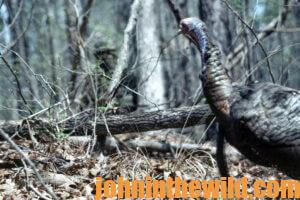 Darty is a camouflage expert. “I had hunted a bird I named the Piney Woods Gobbler for three years,” he told me, “and had him within range once but was never able to shoot. Finally, on a drizzly, rainy day, the turkey stood 25-yards away, but my gun wasn’t pointing right, and I couldn’t move. He looked around a tree straight at me. I believed he couldn’t see me. I was perfectly camouflaged and motionless. I even squinted my eyes so the whites didn’t show. But I know he spotted me. He putted and left.
Darty is a camouflage expert. “I had hunted a bird I named the Piney Woods Gobbler for three years,” he told me, “and had him within range once but was never able to shoot. Finally, on a drizzly, rainy day, the turkey stood 25-yards away, but my gun wasn’t pointing right, and I couldn’t move. He looked around a tree straight at me. I believed he couldn’t see me. I was perfectly camouflaged and motionless. I even squinted my eyes so the whites didn’t show. But I know he spotted me. He putted and left.
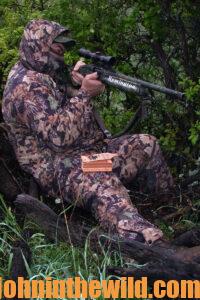 “I was confused and frustrated. I went to the place where the turkey had been and looked back at the tree I’d been sitting against. In the rain the trunk looked very dark and all the foliage looked almost black. I walked to the tree and propped up my hunting coat against it. When I moved to where the turkey had been and looked at my stand again, I saw what the turkey had seen. My green camo coat stood out like a neon light.”
“I was confused and frustrated. I went to the place where the turkey had been and looked back at the tree I’d been sitting against. In the rain the trunk looked very dark and all the foliage looked almost black. I walked to the tree and propped up my hunting coat against it. When I moved to where the turkey had been and looked at my stand again, I saw what the turkey had seen. My green camo coat stood out like a neon light.”
Selecting the right camouflage to blend in with the cover you’re hunting is a must. Darty purchased three different suits of camouflage clothing before he finally matched the cover where he was setting-up. He waited for the next rainy morning and took the Piney Woods Gobbler that had eluded him for so long.
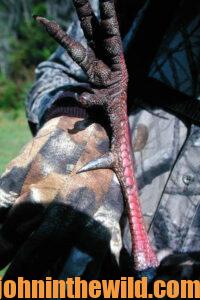 Darty had discovered that rainy days are better than average for turkey hunting. Because most turkey hunters stay at home on rainy days, old gobblers have had few if any encounters with hunters when the weather’s bad and feel more adventurous. He believes, “Turkeys are less skittish and easier to call when it’s raining than they are on bluebird days when most hunters are out.”
Darty had discovered that rainy days are better than average for turkey hunting. Because most turkey hunters stay at home on rainy days, old gobblers have had few if any encounters with hunters when the weather’s bad and feel more adventurous. He believes, “Turkeys are less skittish and easier to call when it’s raining than they are on bluebird days when most hunters are out.”
Darty thinks the traveling turkey is the hardest bird to kill. “A traveling turkey is an old gobbler that will answer a call but moves each time farther and farther from the call,” he explains. “If you try to move closer, he’ll move farther away. By getting in front of this kind of turkey, changing calls and calling only once or twice, I’ve been successful.
“If you call and get an answer, call again a bit later. If he answers, you know the direction he’s taking and have some idea of the path he will take. Circle, and get in front of him, but don’t call. Listen, and look for him to walk by. You may score, but some turkeys simply can’t be killed.”
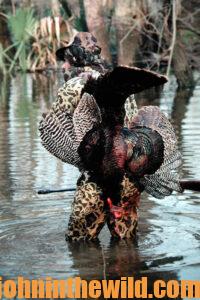 Darty’s Turkey Tips:
Darty’s Turkey Tips:
- Split the distance: Most often an old turkey won’t come all the way to a hen or a caller. He may, however, come halfway and wait for the hen to come to him. By moving quickly half the distance from where you’ve called to the place from which the old gobbler’s answered, you often can take him. Most of the time, Darty doesn’t call after he moves.
- Hunt the hens: A trophy turkey often feels secure with a flock of hens and may stay with them most of the day. If you’re well-camouflaged and can sit still for a long time, try to call the hens. Let them bring the big tom to you.
- Hug the ground: You even may have to lie down on your stomach, and then call or wait for the bird to come. Canny turkeys often spot camouflaged hunters. Shooting from this position of being on your stomach is hard. But by propping yourself up on your elbows, you may be able to shoot.
- Match camouflage to cover: Merely wearing camouflage isn’t enough. You must match the cover where you’re setting-up.
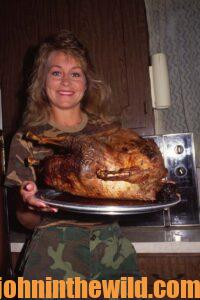
- Know the tom’s territory: Understanding the area where an old gobbler feels comfortable provides a good chance for the hunter to get a shot. Every ole tom favors a place where he hasn’t encountered hunters. By studying the turkey’s habits, you can determine where his sanctuary is.
- Know where the turkey lands: Once you find a trophy turkey’s roost tree, learn where he lands when he leaves the limb in the morning. Set-up nearby. If the turkey flies down but isn’t quite within range, let him pass. The next morning, set-up closer.
- Take your time: Many hunters give up too quickly. Time is often the ultimate weapon. Try to find out about the mistakes other hunters have made hunting this bird. Let the turkey teach you what he’ll do, and where he’ll go. Take the time to scout the bird’s home range. Two or three seasons may be needed to finally take a trophy gobbler.

- Roost and return: Get to the roost in the evening, and call to him. If he answers, you know for sure where he is. Get between him and his hens before daylight the next morning. The old gobbler will be more likely to recognize your call in the morning and come to restrained calling when he flies down.
- Locate preferred ridges and roads: An educated gobbler walks certain ridges and dirt roads where he can see danger at a distance in the spring when woods are thick with foliage. Find tracks along these roads and ridges, and set-up and call there. The turkey’s daily routine follows these roads and ridges.
- Areas to avoid: By knowing where a trophy turkey has encountered other hunters, you can avoid places where he isn’t going to show up.
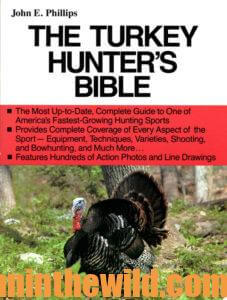 To learn more about hunting turkeys successfully, visit John E. Phillips’ Amazon book page at https://www.amazon.com/John-E.-Phillips/e/B001HP7K6O. For even more information from many of the top turkey hunters and callers, check out the book, “Turkey Hunters’ Bible,” https://www.amazon.com/gp/product/B007HT1IUS/ref=dbs_a_def_rwt_hsch_vapi_taft_p2_i7
To learn more about hunting turkeys successfully, visit John E. Phillips’ Amazon book page at https://www.amazon.com/John-E.-Phillips/e/B001HP7K6O. For even more information from many of the top turkey hunters and callers, check out the book, “Turkey Hunters’ Bible,” https://www.amazon.com/gp/product/B007HT1IUS/ref=dbs_a_def_rwt_hsch_vapi_taft_p2_i7
available in Kindle, print and Audible. You may have to copy and paste this link into your browser. (When you click on the book, notice on the left where Amazon says you can read and hear 10% of the book for free). On the right side of the page and below the offer for a free Audible trial, you can click on Buy the Audible book.

